在《光的世界︰矩陣光學六丙》文章中,我們談過厚透鏡
![]()
,此處
![]() ,
, ![]()
![]() ,
, ![]()
。如薄透鏡 ![]() 一般,都具有前、後聚焦的性質,然而它的數學表達式太過麻煩,並不方便論理與應用。假使一個任意複雜之光學系統竟能夠『等效』於一片『薄透鏡』豈非太美妙耶!且聽聽 Justin Peatross 和 Michael Ware 先生們之大哉論也
一般,都具有前、後聚焦的性質,然而它的數學表達式太過麻煩,並不方便論理與應用。假使一個任意複雜之光學系統竟能夠『等效』於一片『薄透鏡』豈非太美妙耶!且聽聽 Justin Peatross 和 Michael Ware 先生們之大哉論也
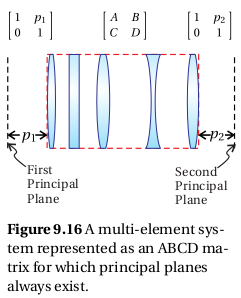

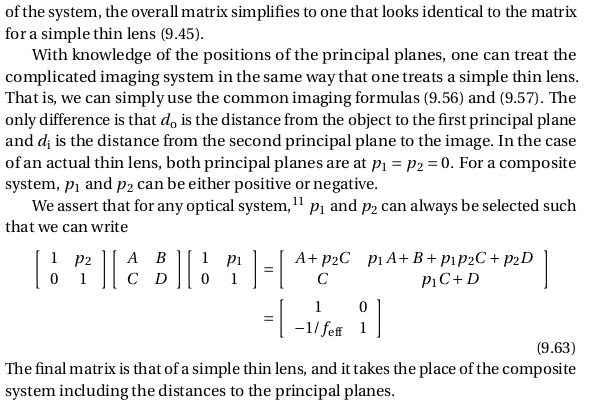
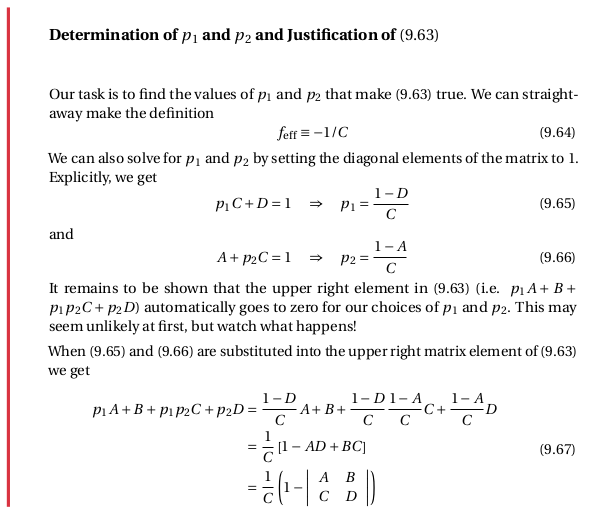
※ 註︰ 若一光學系統光線進、出介質折射率相同,則
![]() 。
。
顯然 ![]() 不等於零。
不等於零。
這將人們帶入『主平面』和『主點』的世界
Cardinal point (optics)
In Gaussian optics, the cardinal points consist of three pairs of points located on the optical axis of a rotationally symmetric, focal, optical system. These are the focal points, the principal points, and the nodal points.[1] For ideal systems, the basic imaging properties such as image size, location, and orientation are completely determined by the locations of the cardinal points; in fact only four points are necessary: the focal points and either the principal or nodal points. The only ideal system that has been achieved in practice is the plane mirror,[2] however the cardinal points are widely used to approximate the behavior of real optical systems. Cardinal points provide a way to analytically simplify a system with many components, allowing the imaging characteristics of the system to be approximately determined with simple calculations.
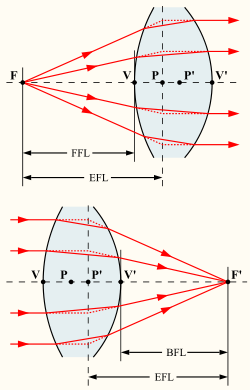
The cardinal points of a thick lens in air.
F, F’ front and rear focal points,
P, P’ front and rear principal points,
V, V’ front and rear surface vertices.
Explanation
The cardinal points lie on the optical axis of the optical system. Each point is defined by the effect the optical system has on rays that pass through that point, in the paraxial approximation. The paraxial approximation assumes that rays travel at shallow angles with respect to the optical axis, so that 

Focal planes
The front focal point of an optical system, by definition, has the property that any ray that passes through it will emerge from the system parallel to the optical axis. The rear (or back) focal point of the system has the reverse property: rays that enter the system parallel to the optical axis are focused such that they pass through the rear focal point.
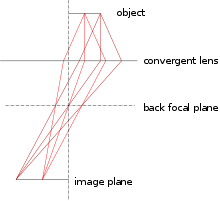
Rays that leave the object with the same angle cross at the back focal plane.
The front and rear (or back) focal planes are defined as the planes, perpendicular to the optic axis, which pass through the front and rear focal points. An object infinitely far from the optical system forms an image at the rear focal plane. For objects a finite distance away, the image is formed at a different location, but rays that leave the object parallel to one another cross at the rear focal plane.
A diaphragm or “stop” at the rear focal plane can be used to filter rays by angle, since:
- It only allows rays to pass that are emitted at an angle (relative to the optical axis) that is sufficiently small. (An infinitely small aperture would only allow rays that are emitted along the optical axis to pass.)
- No matter where on the object the ray comes from, the ray will pass through the aperture as long as the angle at which it is emitted from the object is small enough.
Note that the aperture must be centered on the optical axis for this to work as indicated. Using a sufficiently small aperture in the focal plane will make the lens telecentric.
Similarly, the allowed range of angles on the output side of the lens can be filtered by putting an aperture at the front focal plane of the lens (or a lens group within the overall lens). This is important for DSLR cameras having CCD sensors. The pixels in these sensors are more sensitive to rays that hit them straight on than to those that strike at an angle. A lens that does not control the angle of incidence at the detector will produce pixel vignetting in the images.
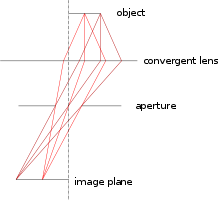
Angle filtering with an aperture at the rear focal plane.
Principal planes and points
The two principal planes have the property that a ray emerging from the lens appears to have crossed the rear principal plane at the same distance from the axis that that ray appeared to cross the front principal plane, as viewed from the front of the lens. This means that the lens can be treated as if all of the refraction happened at the principal planes. The principal planes are crucial in defining the optical properties of the system, since it is the distance of the object and image from the front and rear principal planes that determines the magnification of the system. The principal points are the points where the principal planes cross the optical axis.
If the medium surrounding the optical system has a refractive index of 1 (e.g., air or vacuum), then the distance from the principal planes to their corresponding focal points is just the focal length of the system. In the more general case, the distance to the foci is the focal length multiplied by the index of refraction of the medium.
For a thin lens in air, the principal planes both lie at the location of the lens. The point where they cross the optical axis is sometimes misleadingly called the optical centre of the lens. Note, however, that for a real lens the principal planes do not necessarily pass through the centre of the lens, and in general may not lie inside the lens at all.
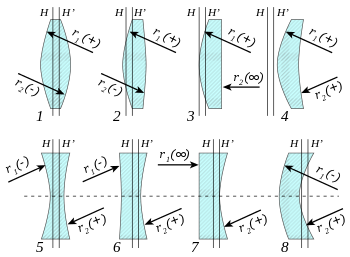
Various lens shapes, and the location of the principal planes.
Nodal points
The front and rear nodal points have the property that a ray aimed at one of them will be refracted by the lens such that it appears to have come from the other, and with the same angle with respect to the optical axis. The nodal points therefore do for angles what the principal planes do for transverse distance. If the medium on both sides of the optical system is the same (e.g., air), then the front and rear nodal points coincide with the front and rear principal points, respectively.
The nodal points are widely misunderstood in photography, where it is commonly asserted that the light rays “intersect” at “the nodal point”, that the iris diaphragm of the lens is located there, and that this is the correct pivot point for panoramic photography, so as to avoid parallax error.[4][5][6] These claims generally arise from confusion about the optics of camera lenses, as well as confusion between the nodal points and the other cardinal points of the system. (A better choice of the point about which to pivot a camera for panoramic photography can be shown to be the centre of the system’s entrance pupil.[4][5][6] On the other hand, swing-lens cameras with fixed film position rotate the lens about the rear nodal point to stabilize the image on the film.[6][7])
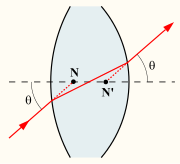
N, N’ The front and rear nodal points of a thick lens.
Surface vertices
The surface vertices are the points where each optical surface crosses the optical axis. They are important primarily because they are the physically measurable parameters for the position of the optical elements, and so the positions of the cardinal points must be known with respect to the vertices to describe the physical system.
In anatomy, the surface vertices of the eye’s lens are called the anterior and posterior poles of the lens.[8]
也可一睹『相對』 □ 面 ○ 點 『定位』之風采乎!!!